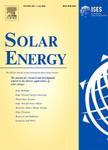版权所有:内蒙古大学图书馆 技术提供:维普资讯• 智图
内蒙古自治区呼和浩特市赛罕区大学西街235号 邮编: 010021

作者机构:Xi An Jiao Tong Univ State Key Lab Multiphase Flow Power Engn Xian 710049 Shaanxi Peoples R China Xi An Jiao Tong Univ Sch Chem Engn & Technol Xian 710049 Shanxi Peoples R China Tsinghua Univ Sichuan Energy Internet Res Inst Chengdu 610213 Sichuan Peoples R China
出 版 物:《SOLAR ENERGY》 (太阳能)
年 卷 期:2019年第177卷第Jan.期
页 面:427-439页
核心收录:
学科分类:0820[工学-石油与天然气工程] 080703[工学-动力机械及工程] 08[工学] 0807[工学-动力工程及工程热物理]
基 金:Key Research Project of Shaanxi Province [2017ZDXM-GY-017] Fundamental Research Funds for the Central Universities [cxtd2017004] Yulin Science and Technology Project [2017KJJH-03]
主 题:Large-scale CPV/T system South-north tracking Steady-state thermal model Unsteady-state thermal model
摘 要:A hybrid CPV/T unit designed in this work concentrates solar radiation by a compound parabolic concentrator (CPC) and converts solar energy into electrical and thermal energy by a PV/T module. The CPC eliminating multiple reflections of solar radiation is defined as the EMR-CPC in our previous work, which improves photoelectric and thermal conversion efficiencies. Two similar CPV/T units were tested with two-axis tracking device and south-north single-axis tracking device respectively, and the average photoelectric conversion efficiencies were 13% and 12%. A large-scale south-north tracking hybrid CPV/T system with sunlight collecting area of 810 m(2) was built to explore practical application of this CPV/T unit. The whole-day thermal efficiency and total thermal output of the large-scale hybrid CPV/T system were 55% and 1,730,039 kJ respectively on April 14, 2017. The steady-state and unsteady-state thermal models of the hybrid CPV/T system were established and the energy loss was analyzed. The calculated whole-day comprehensive thermal efficiencies of the unsteady-state thermal model and the steady-state thermal model were 55.3% and 55.0% respectively, which were close to the measurement 55.8%. However, the steady-state thermal model failed to accurately predict the whole-day thermal efficiency variation of the system. In comparison, the unsteady-state thermal model accurately predicts instantaneous thermal efficiency of the system varying with meteorological conditions and its total daily heat output.